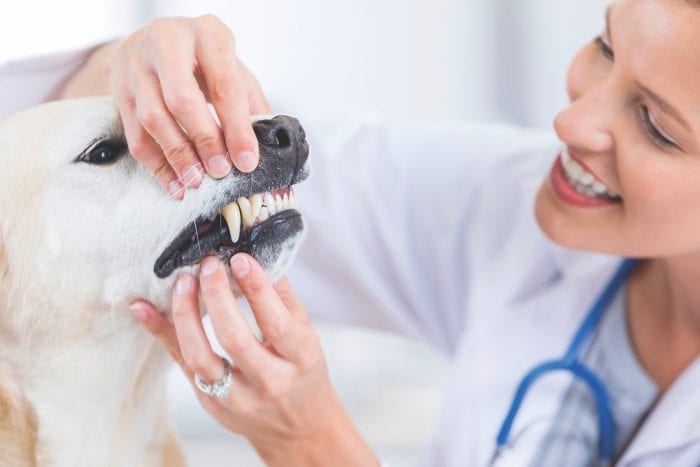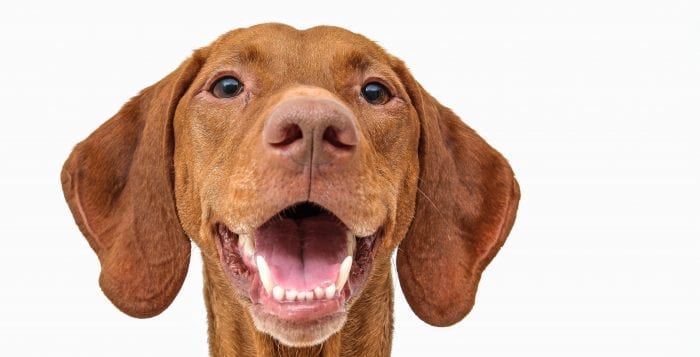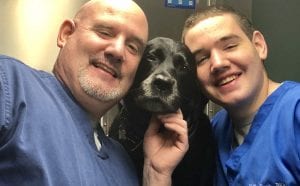By Matthew Kearns, DVM
 February is National Pet Dental Health month so I thought a discussion of periodontal disease is appropriate. Pets tend to suffer less from dental disease, and more from periodontal disease.
February is National Pet Dental Health month so I thought a discussion of periodontal disease is appropriate. Pets tend to suffer less from dental disease, and more from periodontal disease.
Dental disease refers to pathology specifically related to the tooth like caries (superficial decay in the enamel), cavities (deeper decay in the enamel), and tooth fractures. Periodontal disease refers to pathology related to the structures around the tooth. These structures include the gingiva (gums), periodontal ligament (thousands of strands of microscopic strands of connective tissue that hold the tooth in the socket, or jaw), and the perialveolar bone (the bone of the jaw around the tooth).
Periodontal disease usually starts with a buildup of plaque. Plaque is a thin film of saliva, old food and bacteria that can accumulate on the surface of the tooth within 24 hours. If this plaque is not removed, it mineralizes and becomes tartar. Tartar allows a matrix where pathologic bacteria can hide. These bacteria cause chronic inflammation and this inflammation will lead to recession of the gums, breakdown of the periodontal ligament, and resorption of the perialveolar bone. This process is slow and painful because while single rooted teeth may just fall out without intervention, many teeth are multi rooted where one or two roots could be rotten and the third intact. That requires dental extractions at your veterinarian’s and I have yet to meet a pet owner that is happy to hear that.
The key to intervening in this pathology is preventing plaque. No plaque, no tartar. No tartar, no periodontal disease. How do we prevent plaque? Let’s go through the options:
Brushing — brushing is very effective, but also the most frustrating option in my opinion. Brushing needs to be done every day to be effective. If you have the time and your dog or cat is more patient than mine, go for it. Make sure you use pet safe toothpaste. Human toothpaste has too much sodium, fluoride, and is sweetened with saccharin.
Treats, toys, or diets — there are certain toys, treats, chewies, and even special diets to help to clean the teeth. These items will have an abrasive action similar to brushing, increase the production of saliva, and some are treated with special enzymes or compounds to help control the production of tartar. Make sure that if you look in the pet store you find the Veterinary Oral Health Council (VOHC) seal of approval on the packaging or ask your veterinarian which products they recommend.
Do be careful. Many of the treats and diets tend to be calorie dense and can cause an increase in weight if overused. Also, remember you don’t want anything that’s too hard and may cause damage to the enamel or a fractured tooth. There’s a saying, “If it’s something you wouldn’t want to get hit in the knee with, it’s too hard for your pet to chew on.”
I hope this information helps. Remember, “keep on smiling.”
Dr. Kearns practices veterinary medicine from his Port Jefferson office and is pictured with his son Matthew and his dog Jasmine.



 When I bring up dental procedures with pet owners, the concern is pets require anesthesia for dental work. That invariably brings the question, “Is there anything we can do at home to prevent this?” The answer is a resounding “YES!!!”
When I bring up dental procedures with pet owners, the concern is pets require anesthesia for dental work. That invariably brings the question, “Is there anything we can do at home to prevent this?” The answer is a resounding “YES!!!”


